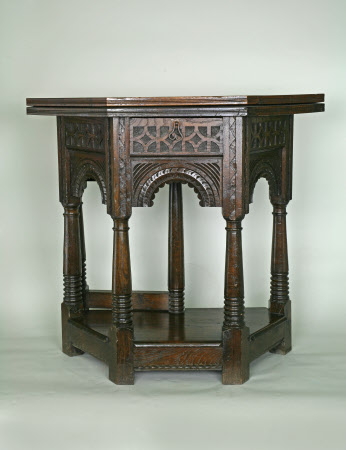'credence'-type table
Category
Furniture
Date
circa 1640 (and later)
Materials
Carved, turned and joined oak, iron drawer handle
Measurements
78.0 x 86.5 x 42.5 cm
Place of origin
Yorkshire
Order this imageCollection
Nostell Priory, West Yorkshire
NT 959696
Summary
An oak, and once inlaid, folding table, of 'credence' type, English, probably Yorkshire/Derbyshire, circa 1640 but with later additions and replacements, including the octagonal folding top with moulded edge, the base with lozenge strapwork-carved friezes, that to the front fitted as a drawer above arcaded aprons. The legs once inlaid to their upper blocks in a dog-tooth pattern, the inlay now lacking, and baluster and multiple ring-turned with block feet. The boards forming the platform stretcher later. The word 'credence' is now thought to be an anachronism, deriving from the use of many of these tables in churches in the 19th century. The term 'credence' table for a folding table of this type does not appear in surviving records until the 19th century.
Full description
Once thought to have come from the 17th century house at Nostell, surviving bills and receipts suggest that much of the oak furniture at Nostell Priory was in fact purchased by Charles Winn (1795 - 1874), who inherited a house with many rooms unfinished. An interested antiquarian, Winn chose to furnish some of the rooms, such as the Lower Hall, Vestibule and West Passage, with furniture of the 16th and 17th centuries. Payments were made by Winn to E. Terry of Thornes, near Wakefield, for 'sundry pieces of antique oak furniture' in 1834 and to John Swaby, a curiosity dealer of Wardour Street, London, for 'several pieces of old carved wood' in May 1821, some of which were probably used by Winn to reconstruct parts of the interior of Wragby Church. Swaby made frequent buying trips to the Continent, and may well have supplied Winn with pieces like NT 959707, a Continental armoire, and NT 959805, a largely 16th century French cabinet in the manner of du Cerceau. Some pieces, such as NT 959709 (a chair), NT 959708 and NT 959826 (both settles), amongst others, were obviously fabricated in the 19th century, although all such pieces at Nostell do incorporate timber from genuine pieces of early furniture. Much of the oak furniture at Nostell is typically Yorkshire in style.
Provenance
Possibly purchased by Charles Winn (1795 – 1874), thence by descent and transferred from the Treasury in lieu of tax in 2007.
References
Westgarth 2009, M. Westgarth, 'A Biographical Register of Nineteenth Century Antique and Curiosity Dealers', Regional Furniture XXIII (2009), 1 - 205, 17, 35 - 41, 109, 131, 169 - 171, 172 & Plates 21 - 27 Raikes, 2003: S.Raikes. ““A cultivated eye for the antique”: Charles Winn and the enrichment of Nostell Priory in the nineteenth century.” Apollo 157.494 (2003): pp.3-8., 5 - 6, Figure 6
